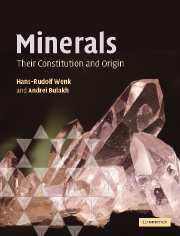Book contents
- Frontmatter
- Contents
- Preface
- Acknowledgments
- Figure credits
- Part I Structural features of minerals
- Part II Physical investigation of minerals
- Part III Variety of minerals and mineral-forming processes
- 14 Classification and names of minerals
- 15 Mineral identification of hand specimens
- 16 Mineral genesis
- 17 Stability of minerals. Principles of thermodynamics
- 18 Solid solutions
- Part IV A systematic look at mineral groups
- Part V Applied mineralogy
- Appendices
- Glossary
- References
- Index
- Plate section
- References
15 - Mineral identification of hand specimens
from Part III - Variety of minerals and mineral-forming processes
- Frontmatter
- Contents
- Preface
- Acknowledgments
- Figure credits
- Part I Structural features of minerals
- Part II Physical investigation of minerals
- Part III Variety of minerals and mineral-forming processes
- 14 Classification and names of minerals
- 15 Mineral identification of hand specimens
- 16 Mineral genesis
- 17 Stability of minerals. Principles of thermodynamics
- 18 Solid solutions
- Part IV A systematic look at mineral groups
- Part V Applied mineralogy
- Appendices
- Glossary
- References
- Index
- Plate section
- References
Summary
Introduction
All geologists must be able to identify – more or less by inspection – most of the common rock-forming minerals and certain important accessory and ore minerals in rocks of all kinds. Such ability is developed largely through practice and experience, involving repeated observations of characteristic simple physical properties. Some of these observations can be made directly, with the naked eye. However, because many of the mineral grains in rocks are exceedingly small, commonly less than 1 mm in diameter, a high-quality hand lens (magnification 5× or 10×) is an indispensable tool for routine field and laboratory observations.
Most hand specimen identification is based only upon the state of aggregation and on simple physical properties that can be determined by inspection or by some rapid and easily performed nondestructive tests. Many common minerals can be identified reasonably accurately in this fashion, even in the field. Note, however, that most of these properties are qualitative descriptions and often vary within a mineral species. In other cases, two distinct minerals may have very similar crystals and physical properties (e.g., proustite–pyrargyrite, quartz–phenakite), and can be told apart only after a detailed examination of their optical characteristics, chemical composition or X-ray diffraction patterns.
Many of the properties used for identification purposes have been introduced in earlier chapters. Here we review those that are most relevant for mineral identification.
- Type
- Chapter
- Information
- MineralsTheir Constitution and Origin, pp. 266 - 275Publisher: Cambridge University PressPrint publication year: 2004



